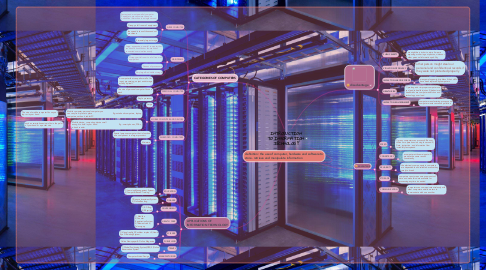
1. definition: the use of computer, hardware and software to store. retrieve and manipulate information
2. CATEGORIES OF COMPUTERS
2.1. SUPERCOMPUTER
2.1.1. Fastest and most powerful computer. Capable to process more than one quadrillion instruction in a single second.
2.1.2. Occupy a full room of equipment
2.1.3. the speed is tens of thousands of processors
2.1.4. Extremely large storage
2.2. MAINFRAME
2.2.1. Large, expensive, powerful computer that can handle hundreds or thousands of connected user simultaneously
2.2.2. Occupy partial room to a full room of equipment
2.2.3. Dozens of processors
2.2.4. Very large & addable storage
2.3. PERSONAL COMPUTER
2.3.1. A computer that can perform all of its input, processing, output and storage activity by itself
2.3.2. The size of personal computer fits on a desk
2.3.3. Single processor
2.3.4. Large
2.4. MOBILE COMPUTER AND DEVICES
2.4.1. Mobile computer- personal computer you can carry from place to place Eg- notebook computers, laptop computers, netbook, tablet PC
2.4.1.1. The size of mobile computer fits on your lapr or in your hand
2.4.2. Mobile device- computing device small enough to hold in your hand Eg- smart phones, PDAs, e-book reader
2.4.2.1. such as smartphone size is fits in the palm of your hand or a pocket size
2.5. EMBEDDED COMPUTERS
2.5.1. Special purpose computer that is function as a component in a larger procduct
2.5.2. Miniature
3. APPLICATIONS OF INFORMATION TECHNOLOGY
3.1. EDUCATION
3.1.1. 1) Learning Management System. 2)Computer Based Training
3.2. FINANCE
3.2.1. 1)Finance Investment System. 2) Online Banking
3.3. GOVERNMENT
3.3.1. 1) E-Filling. 2)E-Syariah
3.4. HEALTH CARE
3.4.1. 1) Medline 2)Counter Registration System 3)Telemedicine 4) Telesurgery
3.5. SCIENCE
3.5.1. 1) Virtual reality 2)Cochlear implant 3) Hawk Eye Officiating System,
3.6. PUBLISHING
3.6.1. Online Newspaper & Online Magazine
3.7. TRAVEL
3.7.1. 1)Global Positioning System(GPS) 2)Online Reservation System
3.8. MANUFACTURING
3.8.1. Computer-Aided Design
4. ADVANTAGE
4.1. SPEED
4.1.1. 1) many computers can process billions or trillions or operations in a single second. 2) Data, instruction, and information flow incredibly fast speeds.
4.2. CONSISTENCY
4.2.1. a computer with same input will produce the same results consistently
4.3. RELIABILITY
4.3.1. the electronic components in computers are dependable and reliable because they rarely to break
4.4. STORAGE
4.4.1. computers can store enomous amounts of data and make this data available for processing anytime is needed
4.5. COMMUNICATION
4.5.1. computers can communicate wirelessly with other computer and allow users to communicate with one another
5. disadvantage
5.1. PUBLIC SAFETY
5.1.1. we might be a victim to crime if we are exposing or sharing out photos, videos or other personal information publicly
5.2. VIOLATION OF PRIVACY
5.2.1. other person moght steal our personal and confidentioal records if they were not protected properly
5.3. IMPACT ON LABOOR FORCE
5.3.1. many employee might jobless if their skills have been replaced by computers
5.4. HEALTH RISK
5.4.1. 1) prolonged or improper computer use can lead to health injuries. 2) behavioral health risks are computer addiction and technology over load
5.5. IMPACT ON ENVIRONMENT
5.5.1. computer manufacturing process and computer waste can cause pollution

